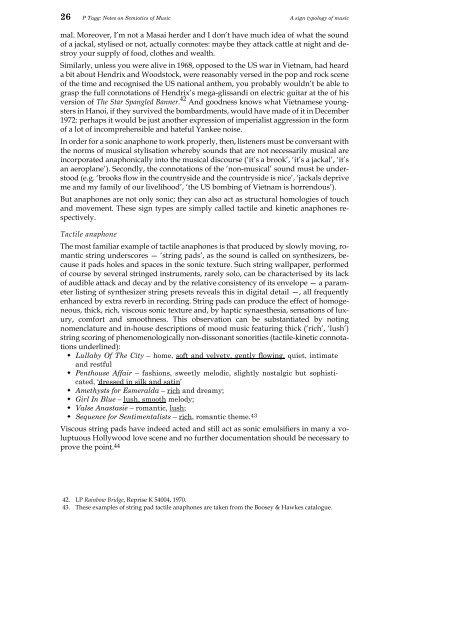Introductory notes to the Semiotics of Music - Philip Tagg's home page
Introductory notes to the Semiotics of Music - Philip Tagg's home page
Introductory notes to the Semiotics of Music - Philip Tagg's home page
Create successful ePaper yourself
Turn your PDF publications into a flip-book with our unique Google optimized e-Paper software.
26 P Tagg: Notes on <strong>Semiotics</strong> <strong>of</strong> <strong>Music</strong> A sign typology <strong>of</strong> music<br />
mal. Moreover, I’m not a Masai herder and I don’t have much idea <strong>of</strong> what <strong>the</strong> sound<br />
<strong>of</strong> a jackal, stylised or not, actually con<strong>notes</strong>: maybe <strong>the</strong>y attack cattle at night and destroy<br />
your supply <strong>of</strong> food, clo<strong>the</strong>s and wealth.<br />
Similarly, unless you were alive in 1968, opposed <strong>to</strong> <strong>the</strong> US war in Vietnam, had heard<br />
a bit about Hendrix and Woods<strong>to</strong>ck, were reasonably versed in <strong>the</strong> pop and rock scene<br />
<strong>of</strong> <strong>the</strong> time and recognised <strong>the</strong> US national an<strong>the</strong>m, you probably wouldn’t be able <strong>to</strong><br />
grasp <strong>the</strong> full connotations <strong>of</strong> Hendrix’s mega-glissandi on electric guitar at <strong>the</strong> <strong>of</strong> his<br />
version <strong>of</strong> The Star Spangled Banner. 42 And goodness knows what Vietnamese youngsters<br />
in Hanoi, if <strong>the</strong>y survived <strong>the</strong> bombardments, would have made <strong>of</strong> it in December<br />
1972: perhaps it would be just ano<strong>the</strong>r expression <strong>of</strong> imperialist aggression in <strong>the</strong> form<br />
<strong>of</strong> a lot <strong>of</strong> incomprehensible and hateful Yankee noise.<br />
In order for a sonic anaphone <strong>to</strong> work properly, <strong>the</strong>n, listeners must be conversant with<br />
<strong>the</strong> norms <strong>of</strong> musical stylisation whereby sounds that are not necessarily musical are<br />
incorporated anaphonically in<strong>to</strong> <strong>the</strong> musical discourse (‘it’s a brook’, ‘it’s a jackal’, ‘it’s<br />
an aeroplane’). Secondly, <strong>the</strong> connotations <strong>of</strong> <strong>the</strong> ‘non-musical’ sound must be unders<strong>to</strong>od<br />
(e.g. ‘brooks flow in <strong>the</strong> countryside and <strong>the</strong> countryside is nice’, ‘jackals deprive<br />
me and my family <strong>of</strong> our livelihood’, ‘<strong>the</strong> US bombing <strong>of</strong> Vietnam is horrendous’).<br />
But anaphones are not only sonic; <strong>the</strong>y can also act as structural homologies <strong>of</strong> <strong>to</strong>uch<br />
and movement. These sign types are simply called tactile and kinetic anaphones respectively.<br />
Tactile anaphone<br />
The most familiar example <strong>of</strong> tactile anaphones is that produced by slowly moving, romantic<br />
string underscores — ‘string pads’, as <strong>the</strong> sound is called on syn<strong>the</strong>sizers, because<br />
it pads holes and spaces in <strong>the</strong> sonic texture. Such string wallpaper, performed<br />
<strong>of</strong> course by several stringed instruments, rarely solo, can be characterised by its lack<br />
<strong>of</strong> audible attack and decay and by <strong>the</strong> relative consistency <strong>of</strong> its envelope — a parameter<br />
listing <strong>of</strong> syn<strong>the</strong>sizer string presets reveals this in digital detail —, all frequently<br />
enhanced by extra reverb in recording. String pads can produce <strong>the</strong> effect <strong>of</strong> homogeneous,<br />
thick, rich, viscous sonic texture and, by haptic synaes<strong>the</strong>sia, sensations <strong>of</strong> luxury,<br />
comfort and smoothness. This observation can be substantiated by noting<br />
nomenclature and in-house descriptions <strong>of</strong> mood music featuring thick (‘rich’, ‘lush’)<br />
string scoring <strong>of</strong> phenomenologically non-dissonant sonorities (tactile-kinetic connotations<br />
underlined):<br />
� Lullaby Of The City – <strong>home</strong>, s<strong>of</strong>t and velvety, gently flowing, quiet, intimate<br />
and restful<br />
� Penthouse Affair – fashions, sweetly melodic, slightly nostalgic but sophisticated,<br />
‘dressed in silk and satin’<br />
� Amethysts for Esmeralda – rich and dreamy;<br />
� Girl In Blue – lush, smooth melody;<br />
� Valse Anastasie – romantic, lush;<br />
� Sequence for Sentimentalists – rich, romantic <strong>the</strong>me. 43<br />
Viscous string pads have indeed acted and still act as sonic emulsifiers in many a voluptuous<br />
Hollywood love scene and no fur<strong>the</strong>r documentation should be necessary <strong>to</strong><br />
prove <strong>the</strong> point. 44<br />
42. LP Rainbow Bridge, Reprise K 54004, 1970.<br />
43. These examples <strong>of</strong> string pad tactile anaphones are taken from <strong>the</strong> Boosey & Hawkes catalogue.














